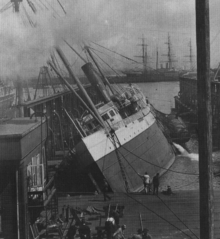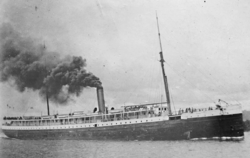Columbia (ship, 1880)
|
||||||||||||||||||||||
|
||||||||||||||||||||||
|
||||||||||||||||||||||
|
||||||||||||||||||||||
|
||||||||||||||||||||||
The Columbia was a passenger ship put into service in 1880 by the US- American shipping company San Francisco and Portland Steamship Company. On July 21, 1907, the ship sank after a collision with a schooner off the California coast near the city of Eureka . 88 people were killed.
The ship
The 2,722 GRT steamship Columbia was built at the John Roach & Sons shipyard in Chester in the US state of Pennsylvania . It was built for the Oregon Railway and Navigation Company (OR & N) and expired on 24 February 1880 from the stack . The ship, 101 meters long and 11.7 meters wide, was made of iron and had four decks and a single four-bladed propeller . The Columbia was one of the first ships to have an electric generator to generate electricity. The ship was completed in May 1880. It then served in passenger and freight traffic on the American west coast and commuted between San Francisco (California) and Portland (Oregon). The ship needed less than ten hours for this route. In her 27 years of service, Columbia made more than 400 crossings on this route. She could carry a total of 382 passengers in the cabin class and the tween deck. The crew consisted of about 60 people.


In 1904, the Oregon Railway and Navigation Company was taken over by the Union Pacific Railroad and renamed the San Francisco and Portland Steamship Company. At the time, the Columbia was already obsolete. During the San Francisco earthquake of 1906 , the Columbia was docked at the Union Iron Works in San Francisco . Due to the earthquake , the ship lay on its side and hit the dock walls. The hull was damaged and water seeped into the hull . It took about two months to make makeshift repairs to the ship. The final repairs should take place at Hunter's Point. On the way there, the crew left the ship because a steam pipe exploded. It was not until January 1907 that the Columbia was back in service.
The misfortune
On Saturday, July 20, 1907, the Columbia ran under the command of Captain Peter A. Doran in San Francisco for another crossing to Portland . There were 72 crew members and 129 passengers on board, 108 of them in the cabin class and 21 in the tween deck. Among the passengers were many teachers returning from a teachers' meeting in Los Angeles . Towards evening the ship was level with Shelter Cove when it fell into thick fog . Captain Doran did not slow down.
The Columbia was approached from the south by the wooden schooner San Pedro (457 t), which had left Eureka a few hours earlier under the command of Captain Magnus Hanson with a cargo of 390,000 redwood boards . Both ships sounded their foghorns . The visibility was very narrow. The first officer Ben Hendricksen on board the San Pedro also did not reduce the speed of his ship. He only ordered a slight turn to starboard to give his ship more space. The two ships came exactly towards each other. About fifteen minutes after midnight on July 21, the Columbia lookout could see the San Pedro approaching. “Full power back” was ordered on both ships, but it was too late.
A few minutes after visual contact, the San Pedro rammed the starboard side of the Columbia . The collision occurred 12 nautical miles southwest of Shelter Cove. The wooden bow of the schooner was severed by the force of the impact. The backward movement ordered by Captain Doran released the Columbia from the San Pedro . The Columbia immediately leaned to starboard and began to sink over the bow. Numerous passengers streamed on deck in nightwear. When the bridge was under water, died the ship's whistle. Many passengers jumped overboard. Captain Doran stayed on the bridge with First Officer WF Whitney to the end. Afterwards, several passengers reported on his last words: “Goodbye. God protect you". During the sinking, there was a boiler explosion on board .
In the eight minutes that the Columbia sank, not all lifeboats could be launched. Six boats and three rafts were detached from the crew and floated free. One of these boats, in which 18 people were sitting, reached the country without assistance. Several passengers had their life jackets put on the wrong way round, making it difficult to keep their heads above water. The steamer Roanoke and the coastal ship George W. Elder arrived at the scene of the accident and helped to rescue the passengers.
Of the 251 passengers and crew members, 88 were killed in the sinking, including Captain Doran and most of the women and all children on board. The damaged but still buoyant San Pedro was taken in tow by the George W. Elder and towed to Eureka.
Web links
- Entry in the wreck database
- Description of the sinking in the non-fiction book A Long, Dangerous Coastline: Shipwreck Tales from Alaska to California by Anthony Dalton
- Report of the sinking in the New York Times, July 23, 1907
- Report of the sinking in the New York Times, July 24, 1907
- Report of the sinking in Cranbury Press, July 26, 1907

